ref
ref,isRef
在 Vue 3 中,ref 是一个函数,用于创建响应式的数据。它接受一个参数作为初始值,并返回一个包装过的响应式对象。
ref跟vue2的以下这段代码是一个意思,也就是创建响应式数据:
<template>
<div>
</div>
</template>
<script setup lang='ts'>
export default{
data(){
return {
age:18
}
}
}
</script>
<style scoped>
</style>使用ref去写则是这样的:
<template>
<div>
ref {{ rarrot }}
</div>
<button @click="change">点击我</button>
</template>
<script setup lang='ts'>
import { ref, isRef } from 'vue'
const rarrot = ref({ name: "rarrot" })
const change = () => {
// 通过value去改变rarrot的值
rarrot.value.name='nihao'
console.log("🚀", rarrot)
// 用于检测是否为响应式对象
console.log(isRef(rarrot))
}
</script>
<style scoped></style>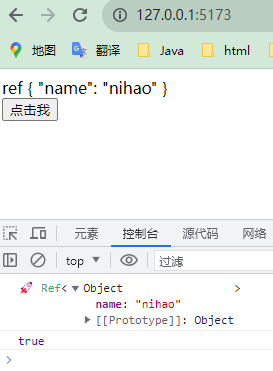
shallowRef,triggerRef
在 Vue 3 中,shallowRef 和 ref 区别如下:
| 响应式对象的处理方式 | 性能影响 | |
|---|---|---|
| ref | ref 创建的响应式对象会对其值进行深层次的响应式转换。 当访问或修改 ref 返回的对象时Vue 会自动追踪依赖并进行视图更新。 | 由于 ref 对值进行深层次的响应式转换,当值是复杂对象或数组时,会有一定的性能开销因为 Vue 需要递归地追踪其所有属性的变化 |
| shallowRef | shallowRef 创建的响应式对象只对其值进行浅层次的响应式转换。 当访问或修改 shallowRef 返回的对象时,Vue 只会追踪该对象本身的变化,而不会深度追踪其内部属性的变化。 | 由于 shallowRef 只对值进行浅层次的响应式转换,对于复杂对象或数组,它的性能开销较低。因为 Vue 只会追踪对象本身的变化,而不会深度追踪其内部属性的变化。 |
示例:
通过triggerRef(rarrot2)和rarrot2.value={ name:'nihao2' }这两种方式会更新收集的依赖,也就是视图的更新,看代码:
<template>
<div>
shallowRef {{ rarrot2 }}
</div>
<button @click="change">点击我</button>
</template>
<script setup lang='ts'>
import { shallowRef, triggerRef } from 'vue'
// ref shallowRef
// ref深层次 shallowRef浅层次的响应
// shallowRef跟ref混写的话,改变ref,shallowRef的页面也会被修改,原因是调用了triggerRef()
const rarrot2 = shallowRef({ name: 'rarrot2' })
const change = () => {
// shallowRef以下这么修改会导致对象被修改,但是页面上没有被修改
rarrot2.value.name = 'nihao2'
triggerRef(rarrot2)//triggerRef会强制更新收集的依赖
console.log("🚀 rarrot2", rarrot2)
// shallowRef用以下这种方式对象和页面上都会被修改
// rarrot2.value={
// name:'nihao2'
// }
// console.log("🚀 rarrot2", rarrot2)
}
</script>
<style scoped></style>下图将triggerRef(rarrot2)和rarrot2.value={ name:'nihao2' }都注释了:
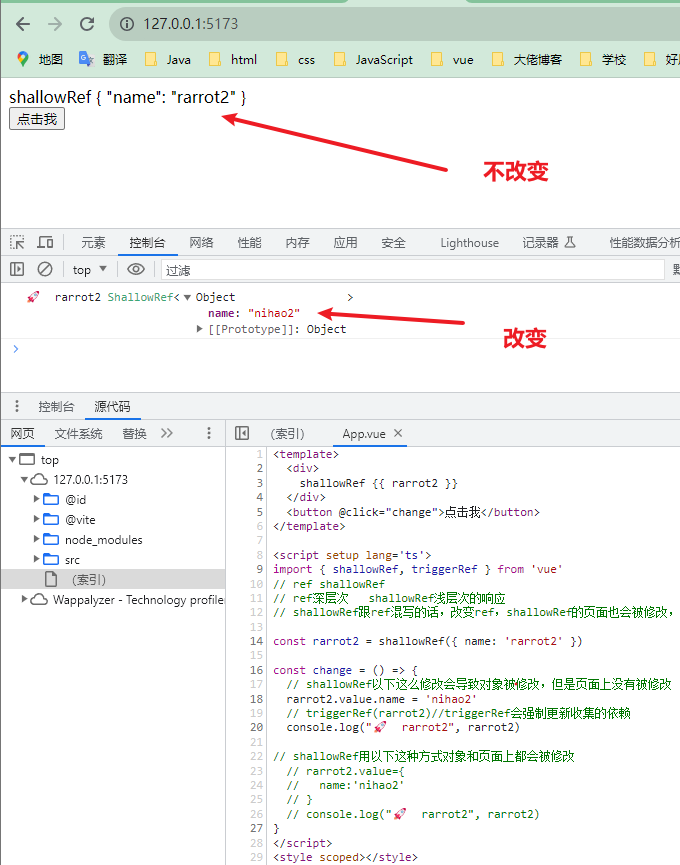
customRef
在 Vue 3 中,customRef 是一个函数,用于创建自定义的响应式数据。它接受一个工厂函数作为参数,该工厂函数负责定义自定义的响应式行为,并返回一个包装过的响应式对象。
通过使用 customRef,你可以完全控制响应式数据的依赖追踪和触发更新的逻辑。这对于实现一些特定的响应式行为或处理复杂的数据情况非常有用。看代码:
<template>
<div>
customRef {{ rarrot3 }}
</div>
<button @click="change">点击我</button>
</template>
<script setup lang='ts'>
import { isRef, customRef } from 'vue'
function myRef<T>(value: T) {
let timer:any
// track 用于追踪依赖,trigger 用于触发更新
return customRef((track, trigger) => {
return {
get() {
track()
return value
},
set(newVal) {
clearTimeout(timer)
timer=setTimeout(()=>{
console.log('触发了')
value=newVal
timer=null;
trigger()
},500)
}
}
})
}
// 对其进行赋值时,会调用customRef的get()方法去收集这个依赖
const rarrot3=myRef<string>('rarrot3')
console.log(isRef(rarrot3))//true
console.log(rarrot3)
const change = () => {
//.value会调用customRef的set()方法去更新收集的这个依赖
rarrot3.value='nihao3'
}
</script>
<style scoped></style>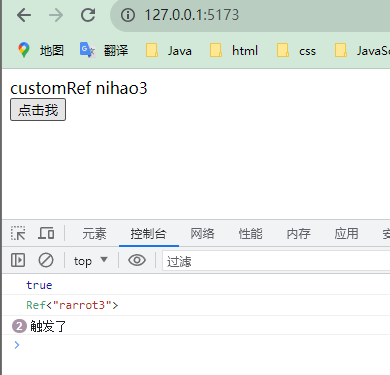
以上代码中使用了一个简单的防抖,防止用户过快点击,导致卡顿,防抖会使得用户在过快点击时不会触发定时器,在停止点击后才触发,以下为代码解释:
这段代码的作用是在修改 rarrot3 的值后,延迟500毫秒才触发更新。这是通过在 set() 方法中使用 setTimeout() 来实现的。在 set() 方法中,清除之前的定时器(如果有的话),然后设置一个新的定时器来延迟更新。当定时器触发时,就将新的值赋给 value,并通过调用 trigger() 方法来触发更新。
ref 小妙招
我们在使用ref后,想要打印返回的响应式对象,但是给了一堆属性,如下图:
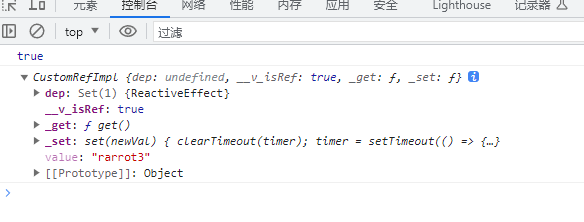
所以可以进行以下设置:
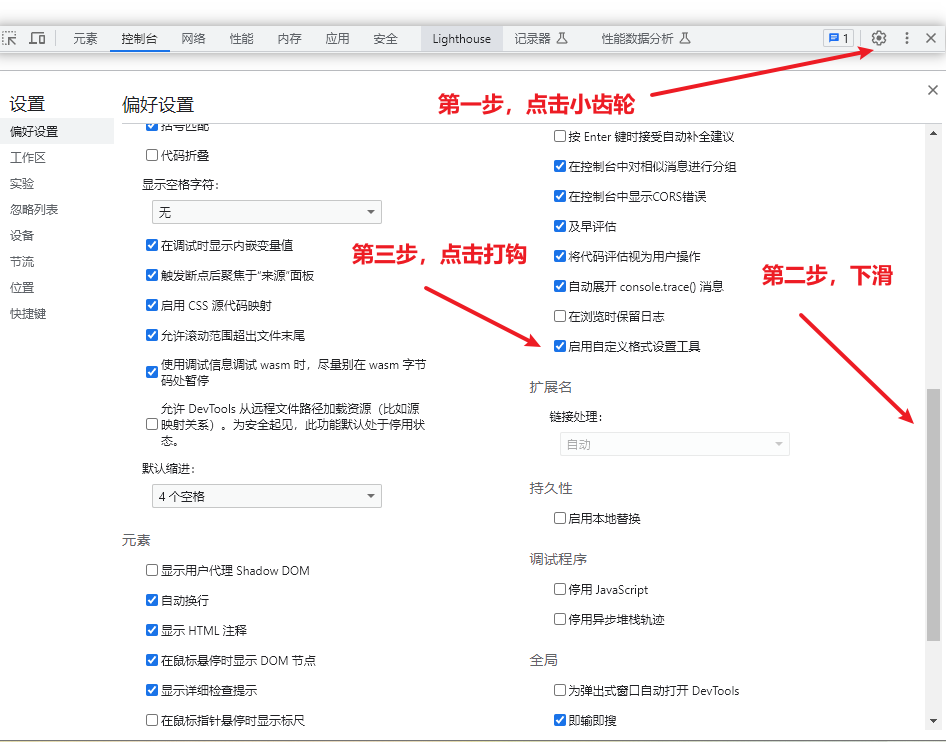
设置之后打印的效果就变得很简洁,如下图所示:

用ref操作DOM
看代码:
<template>
<div ref="domm">
我是domm
</div>
<button @click="change">点击我</button>
</template>
<script setup lang='ts'>
import { ref } from 'vue'
const domm=ref<HTMLDivElement>()
const change = () => {
// ?. 是可选链操作符(Optional Chaining Operator)
// 在访问对象的属性或方法之前,需要先确保对象本身不为 null 或 undefined
// 如果对象为 null 或 undefined,直接访问其属性或方法将会导致 TypeError 错误。
console.log(domm.value?.innerText)
}
</script>
<style scoped></style>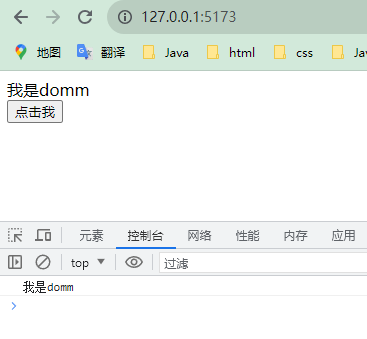
从源码解释ref和shallowRef的区别
ref的创建过程
先说一下ref的创建过程:
/**
* 获取一个内部值并返回一个reactive(响应)和mutable(可变)的 ref 对象
* 有一个指向内部值的属性`.value`
*
* @param value - The object to wrap in the ref.
* @see {@link https://vuejs.org/api/reactivity-core.html#ref}
*/
export function ref<T extends Ref>(value: T): T
export function ref<T>(value: T): Ref<UnwrapRef<T>>
export function ref<T = any>(): Ref<T | undefined>
export function ref(value?: unknown) {
return createRef(value, false)
}以上运用函数的重载,以适应多种传入的类型。
上面代码中调用createRef(value, false),value为用户传入的值,代码如下:
function createRef(rawValue: unknown, shallow: boolean) {
if (isRef(rawValue)) {
return rawValue
}
return new RefImpl(rawValue, shallow)
}先判断了rawValue是否为响应式对象,是就直接返回rawValue,否则调用RefImpl(rawValue, shallow)创建ref对象。
记住,这里的shallow传入为false。
上面代码中不是ref对象就调用了RefImpl(rawValue, shallow),这里是将rawValue和shallow传入到构造方法中,代码如下:
class RefImpl<T> {
private _value: T
private _rawValue: T
public dep?: Dep = undefined
public readonly __v_isRef = true
constructor(value: T, public readonly __v_isShallow: boolean) {
this._rawValue = __v_isShallow ? value : toRaw(value)
this._value = __v_isShallow ? value : toReactive(value)
}
get value() {
trackRefValue(this)
return this._value
}
set value(newVal) {
// 判断是否为浅响应式对象,shallowRef传入的__v_isShallow为true,
// isShallow(newVal)判断传入的值是否为浅层响应式,
// isReadonly(newVal)判断传入的值是否为只读响应式对象
// 只要三个条件中有一个为true,useDirectValue就为true
const useDirectValue =this.__v_isShallow || isShallow(newVal) || isReadonly(newVal)
// 当useDirectValue为false,也就是为深层次响应对象时,就将其转换为原始对象
newVal = useDirectValue ? newVal : toRaw(newVal)
// 这里比较原始对象
if (hasChanged(newVal, this._rawValue)) {
this._rawValue = newVal
this._value = useDirectValue ? newVal : toReactive(newVal)
triggerRefValue(this, newVal)
}
}
}以上代码先定义私有的_value和_rawValue,这个类中的构造方法的参数__v_isShallow前面传入为false,所以又会调用toReactive(value)。
toReactive(value)的代码如下:
export const toReactive = <T extends unknown>(value: T): T =>
isObject(value) ? reactive(value) : value以上这段代码就是说判断value是不是一个引用类型,是的话就会调用reactive(value),这个方法可以用来将普通对象转换为响应式对象,也就是说当对象的属性发生变化时,Vue 可以检测到这些变化并自动更新相关的视图。
shallowRef的创建过程
declare const ShallowRefMarker: unique symbol
export type ShallowRef<T = any> = Ref<T> & { [ShallowRefMarker]?: true }
/**
* Shallow version of {@link ref()}.
*
* @example
* ```js
* const state = shallowRef({ count: 1 })
*
* // 这不会触发响应式系统的变化
* state.value.count = 2
*
* // 这会触发响应式系统的变化
* state.value = { count: 2 }
* ```
*
* @param value - The "inner value" for the shallow ref.
* @see {@link https://vuejs.org/api/reactivity-advanced.html#shallowref}
*/
export function shallowRef<T extends object>(
value: T
): T extends Ref ? T : ShallowRef<T>
export function shallowRef<T>(value: T): ShallowRef<T>
export function shallowRef<T = any>(): ShallowRef<T | undefined>
export function shallowRef(value?: unknown) {
return createRef(value, true)
}这一段跟上面ref的同理了,只不过这里传入到createRef的shallow为true。
因为传入为true,所以在构造方法中,就会直接返回value并赋值给RefImpl类的_value私有属性,
- 在读取时会调用
get()方法,里面的trackRefValue(this)会收集依赖 - 设置值时会调用
set(newVal)方法,这里的set(newVal)会先判断值是否改变,有改变的话将新值传递给 _rawValue - 如果之前已经使用了浅层模式或者新值是浅层响应式或只读响应式,则直接使用新值,否则使用
toReactive(newVal)函数将新值转换为响应式对象。 - 最后再调用
triggerRefValue(this,newValue)函数,触发对该 customRef 对象的依赖更新。
之所以ref跟shallowRef同时使用,都会进行视图更新,因为ref会调用triggerRefValue(this, newVal),就会把收集的依赖都进行更新。
疑问
- 为什么深层次响应式对象要使用toRaw()转换为原始对象进行比较,而浅层次响应式对象不用转换?
看下方。
- 还有一个疑问就是,以下会更新视图的变化是怎么一回事?
const rarrot2 = shallowRef({ name: 'rarrot2' })
rarrot2.value={ name:'nihao2' }而以下这样又不会更新视图
const rarrot2 = shallowRef({ name: 'rarrot2' })
rarrot2.value.name='nihao2'解答
其实两个问题的答案都在set()方法里,看源代码:
set value(newVal) {
...
// 当useDirectValue为true,也就是为深层次响应对象时,就将其转换为原始对象
newVal = useDirectValue ? newVal : toRaw(newVal)
if (hasChanged(newVal, this._rawValue)) {
this._rawValue = newVal
this._value = useDirectValue ? newVal : toReactive(newVal)
triggerRefValue(this, newVal)
}
}export const hasChanged = (value: any, oldValue: any): boolean =>
!Object.is(value, oldValue)① 这里深层次对象需要用toRaw()转换为原始对象进行比较,原因为直接比较的话比较的是引用,那就没有变化,需要比较的是属性值。
② 这里直接比较浅层次响应式对象的话,比较的是引用,新值的引用和旧值的引用,在只改变属性的情况下,还是一样的。
但是如果通过rarrot2.value={ name:'nihao2' },则改变了引用,所以就会调用if里面的条件了。
